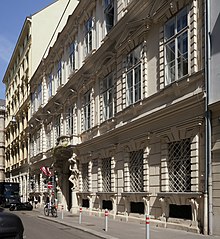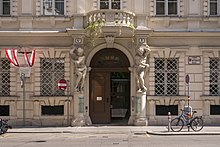Palais Caprara-Geymüller

The Palais Caprara-Geymüller is a palace in the 1st district of Vienna, completed in 1698 . It is located at Wallnerstrasse 8 and is one of the oldest baroque buildings in Vienna .
history
17th to 18th centuries
In 1687 , Field Marshal Enea Silvio Graf von Caprara , who came from a Bolognese family, bought a house on Wallnerstrasse, but he soon had it torn down. Eleven years later, on behalf of the Count of Caprara, the architect Domenico Egidio Rossi, also from Bologna, built the Palais Caprara. When planning, he oriented himself on the palace architecture customary in Italy at the time. For the main portal, cornices, steps and other components of hard was Kaiserstein from the Imperial quarry used.
Structural changes were made at the beginning of the 18th century, for example the two atlas statues made of Eggenburg stone were added to the entrance gate. The palace then remained in the possession of the Caprara family for almost 100 years until it was bought by Prince Carl von Liechtenstein in 1796. A year later it became the property of Baron Wimmer before the French ambassador Jean Baptiste Bernadotte , later King of Sweden, rented the palace in 1798 . But since he hoisted the tricolor at a festival on April 13th, he had to leave the country that same year because of uprisings among the people.
At the end of 1798, Johann Heinrich and Johann Jakob Geymüller bought the building, which was to be called Palais Caprara-Geymüller from now on. Johann Jakob Geymüller was a wealthy manufacturer and banker and among other things he owned the so-called Geymüllerschlössel in Pötzleinsdorf . The Geymüller brothers had the interior of the palace redesigned in the Empire style.
19th century until today
After the financial ruin of the Geymüller bank, the building was sold to the Barons Pouthon in 1897 and to the state of Lower Austria in 1905 , which used it as a state museum from the beginning of 1912 . In addition to private owners, the Palais Caprara-Geymüller was also home to the consular department of the British Embassy . After a general renovation under the leadership of the architect Alois Machatschek from 1986 to 1988 by the current owner, a real estate company, the house was the domicile of the Syrian embassy used. The Vienna Stock Exchange and related companies have had their headquarters here since 2001, including Bronner Online AG since April 2007 . In October 2007, the Austrian branch of Thomson Financial moved into the building.
architecture
Since the Palais Caprara-Geymüller has a rather atypical design for baroque Vienna, the Viennese did not like it at first, but they were soon impressed by the massive building that blended into the cityscape without any problems. The facade consists of a five-axis central risalit and a two-axis side risalit each. The horizontal façade is structured by ledges above the floors. In addition, the window are Beletage alternately decorated with triangular gables and arches. The strict structure of the floors is representative of the Italian palace architecture. The entrance gate is bordered by two atlases which support the balcony above. The entrance hall is a transverse, wide columned hall, from which a three-armed staircase leads to the first floor. The walls of the now subdivided ballroom, which previously stretched the entire length of the building, were almost completely covered with architectural paintings that came to light after a restoration . Only two rooms of the high-quality Empire furnishings remained: the Geymüller Salon and the Pompeian Room , which is now in the Wien Museum .
literature
- Hermine Cloeter : Features. In the Palais Geymüller. In: Neue Freie Presse , Morgenblatt, No. 17071/1912, March 2, 1912, pp. 1–5. (Online at ANNO ). .
- Hermine Cloeter: Houses and People of Vienna . Schroll, Vienna 1920.
- Bruno Grimschitz : Viennese Baroque Palaces , 1944
- Richard Groner , Felix Czeike : Vienna as it was. A reference work for friends of old and new Vienna , 1965.
- Laurin Luchner: Schlösser in Österreich , 1978, ISBN 3-406-04507-3 .
- Felix Czeike: Vienna District Culture Guide Inner City , 1983, ISBN 3-224-16246-5 .
- Nina Nemetschke, Georg Kugler: Lexicon of Viennese Art and Culture , 1990, ISBN 3-8000-3345-3 .
- Wolfgang Kraus , Peter Müller: Vienna Palace . Blanckenstein, Munich / Vienna 1991, ISBN 3-926678-22-4 .
- Felix Czeike: Historical Lexicon Vienna , 1994
- Helmuth Furch: Kaiserstein in Viennese buildings, 300 examples . In: Messages from the Kaisersteinbruch Museum and Culture Association . Issue 59/2000, ZDB -ID 2302633-9 . Museum and cultural association, Kaisersteinbruch 2000.
- Georg Clam Martinic : Austrian Burgenlexikon , 2007, ISBN 3-902397-50-0 .
Web links
- Entry about Palais Caprara-Geymüller on planet-vienna.com
- Entry via Palais Caprara on Burgen-Austria
Individual evidence
- ↑ Cloeter: Im Palais Geymüller , p. 1.
Coordinates: 48 ° 12 ′ 37 ″ N , 16 ° 21 ′ 57 ″ E

